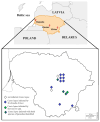Identification of Sarcocystis and Trichinella Species in Muscles of Gray Wolf (Canis lupus) from Lithuania
- PMID: 38393103
- PMCID: PMC10892562
- DOI: 10.3390/vetsci11020085
Identification of Sarcocystis and Trichinella Species in Muscles of Gray Wolf (Canis lupus) from Lithuania
Abstract
Apicomplexan Sarcocystis and Trichinella nematodes are food-borne parasites whose life cycle is carried-out in various wildlife and domestic animals. The gray wolf (Canis lupus) is an apex predator acting as an ecosystem engineer. This study aimed to identify the species of Sarcocystis and Trichinella found in the muscles of gray wolves in Lithuania. During the 2017-2022 period, diaphragm, heart, and hind leg samples of 15 animals were examined. Microscopical analysis showed the presence of two types of Sarcocystis parasites in 26.7% of the analyzed muscle samples. Based on the sequencing of five loci, nuclear 18S rDNA, 28S rDNA, ITS1, mitochondrial cox1, and apicoplast rpoB, S. arctica, and S. svanai were identified. The current work presents the first report of S. svanai in gray wolf. Phylogenetically, S. svanai clustered together with S. lutrae, infecting various carnivorans, and S. arctica was most closely related to S. felis from domestic cats. Trichinella spp. were found in 12 gray wolves (80%). For the first time, Trichinella species were molecularly identified in gray wolves from Lithuania. Trichinella britovi was confirmed in all of the isolated Trichinella larvae using a multiplex PCR. Gray wolves in Lithuania may serve as a major source of zoonotic pathogens due to the presence of these parasites.
Keywords: Sarcocystis; Trichinella; gray wolf; host-specificity; molecular identification; phylogeny.
Conflict of interest statement
The authors declare no conflicts of interest.
Figures





Similar articles
-
High prevalence of Sarcocystis and Trichinella infections in skeletal muscles of gray wolves (Canis lupus arctos) from Alaska, USA.Vet Parasitol Reg Stud Reports. 2025 Feb;58:101207. doi: 10.1016/j.vprsr.2025.101207. Epub 2025 Jan 31. Vet Parasitol Reg Stud Reports. 2025. PMID: 40049989
-
Identification and genetic characterization of Sarcocystis arctica and Sarcocystis lutrae in red foxes (Vulpes vulpes) from Baltic States and Spain.Parasit Vectors. 2018 Mar 12;11(1):173. doi: 10.1186/s13071-018-2694-y. Parasit Vectors. 2018. PMID: 29530098 Free PMC article.
-
MOLECULAR AND MORPHOLOGICAL CHARACTERIZATION OF SARCOCYSTIS INFECTIONS IN THE MUSCLES OF GRAY WOLVES (CANIS LUPUS) FROM MINNESOTA SUGGEST THEY MAY SERVE AS RESERVOIRS FOR INFECTION IN DOMESTICATED DOGS.J Parasitol. 2024 Sep 1;110(5):471-485. doi: 10.1645/24-72. J Parasitol. 2024. PMID: 39326880
-
Trichinella britovi in the jackal Canis aureus from south-west Iran.J Helminthol. 2014 Dec;88(4):385-8. doi: 10.1017/S0022149X1300028X. Epub 2013 May 9. J Helminthol. 2014. PMID: 23656910 Review.
-
Trichinella infections in animals and humans of Iran and Turkey.Front Med (Lausanne). 2023 Feb 2;10:1088507. doi: 10.3389/fmed.2023.1088507. eCollection 2023. Front Med (Lausanne). 2023. PMID: 36817781 Free PMC article. Review.
Cited by
-
Sarcocystis Cymruensis in the Brown Rat (Rattus Norvegicus) from an Urban District in Kuwait: Detailed Morphologic and Molecular Characterization.Acta Parasitol. 2025 Jan 7;70(1):11. doi: 10.1007/s11686-024-00952-6. Acta Parasitol. 2025. PMID: 39775129
-
First report of Sarcocystis halieti in Asia: the genetic confirmation in muscles of the Eurasian sparrowhawk (Accipiter nisus) from Iran.Sci Rep. 2025 Feb 27;15(1):6989. doi: 10.1038/s41598-025-90666-0. Sci Rep. 2025. PMID: 40011492 Free PMC article.
-
Molecular Confirmation of Raptors from Spain as Definitive Hosts of Numerous Sarcocystis Species.Animals (Basel). 2025 Feb 23;15(5):646. doi: 10.3390/ani15050646. Animals (Basel). 2025. PMID: 40075929 Free PMC article.
-
High richness of ungulate Sarcocystis species in intestines of the grey wolf (Canis lupus) from Lithuania.Vet Res Commun. 2025 Jun 23;49(4):235. doi: 10.1007/s11259-025-10804-x. Vet Res Commun. 2025. PMID: 40549019 No abstract available.
References
-
- Boitani L.P., Kaczensky F., Alvares H., Andrén V., Balys J., Blanco G., Chapron S., Chiriac D., Cirovic N., Drouet-Houguet C., et al. Assessment of the Conservation Status of the Wolf (Canis Lupus) in Europe. Prepared for the Berne Convention on the Conservation of European Wildlife and Natural Habitats and the Council of Europe; Strasbourg, France: 2022. [(accessed on 20 November 2023)]. pp. 1–25. Available online: https://rm.coe.int/inf45e-2022-wolf-assessment-bern-convention-2791-5979....
-
- Nowak R.M. A perspective on the taxonomy of wolves in North America. In: Carbyn L.N., editor. Wolves in Canada and Alaska: Their Status, Biology, and Management. Canadian Wildlife Service; Ottawa, ON, Canada: 1983. pp. 10–19.
-
- Paquet P.C., Carbyn L.N. Gray wolf. In: Feldhamer A.G., Thompson B.C., Joseph A., Chapman J.A., editors. Wild Mammals of North America: Biology, Management, and Conservation. 2nd ed. John Hopkins University Press; Baltimore, MD, USA: 2003. pp. 482–510.
-
- Mech L.D., Boitani L. Wolves: Behavior, Ecology, and Conservation. The University of Chicago Press; Chicago, IL, USA: 2003.
-
- Ciucci P., Reggioni W., Maiorano L., Boitani L. Long-distance dispersal of a rescued wolf from the northern Apennines to the western Alps. J. Wildl. Manage. 2009;73:1300–1306. doi: 10.2193/2008-510. - DOI
LinkOut - more resources
Full Text Sources
Miscellaneous

